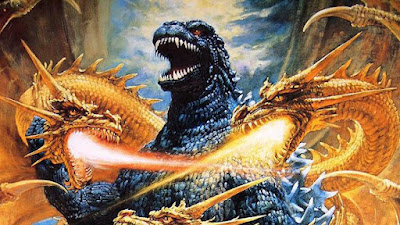Originally published on Set The Tape
Following the commercial failure of 1989’s Godzilla vs Biollante, Toho was in a tough position of which route to take their iconic monster in its next instalment. Due in part to the more complex plot in Godzilla vs Biollante that children struggled to follow, and the large competition the movie faced from Back To The Future II, the studio decided that they needed to introduce more fantastical elements to the next film, as well as time travel. This was the beginning of Godzilla vs King Ghidorah.
The film begins in 1992, and sees a mysterious spaceship land at mount Fuji. Upon investigiating the strange vessel, people are shocked to find that the ship doesn’t come from another planet, but Earth’s future. On board the ship are a group called the Futurians, who have come backwards in time to warn modern day Japan that in their time, 2303, Godzilla has completely destroyed the nation. They plan to travel even further back in time to 1944, where they believe that they can prevent Godzilla from ever coming into being.
There have been reports surfacing of a strange event that occurred on Lagos Island in the pacific, where a group of American GIs were attacked and killed by a strange dinosaur-like creature. The Futurians believe that this dinosaur would go on to be irradiated by Atomic testing in 1954, becoming Godzilla. Travelling back to 1944, they’re able to locate the creature following the attack on the GIs, and transport it to the Bering Strait.
When they return to 1992 they find a Japan under the domination of the monster King Ghidorah. It turns out that the future they warned about was a lie, and that they wanted to take control of and destroy Japan to prevent it becoming a dominant superpower in the future. With King Ghidorah raging across Japan, one of the Futurians, Emmy (Anna Nakagawa) makes an agreement with a modern day scientist to try and repair the damage that’s been done.
The scientist learns that in 1977 a Russian nuclear submarine sank in the Bering Strait, and believes that this may have mutated the dinosaur into Godzilla. Travelling to the Bering Strait, they’re able to locate Godzilla and bring him back to Japan to fight Ghidorah. Whilst Godzilla is successful, killing the monster by destroying one of his heads, he then begins to attack Japan. Emmy travels into the future, returning with the mechanised corpse of King Ghidorah, now Mecha-King Ghidora, and uses it to fight Godzilla back into the sea, saving Japan from destruction.
To say the plot of Godzilla vs King Ghidorah is bit complex is something of an understatement, as this is one of the more complicated plots to exist in any of the series. The use of time travel, the ever shifting present and alternate pasts, are definitely inspired by the more complex nature of Back To The Future II, though I’m not as sure that this film pulled off its time travel concepts as well.
One of the biggest reasons why the time travel in this film doesn’t work as well, at least for western audiences, is due to what at first appears to be a number of plot holes. After returning from the past and having moved the dinosaur that would become Godzilla, people are still aware of what Godzilla is, and it only seems to have changed certain events. Whilst this seems to be a strange plot hole in the English dubbed version of the film, this is actually playing into the more complex history of the franchise. You see, the creature whose creation they had just prevented wasn’t the creature that appeared in the very first Godzilla in 1954.
That version of Godzilla was not a mutated dinosaur, or at least not the same mutated dinosaur, and as such was still able to appear when it did and cause destruction across Japan. The creature that this film prevented the creation of was the version of Godzilla that would appear in 1984’s The Return of Godzilla, which saw a new version of the monster appearing, with the only film coming before it acknowledged being the original. As such, this film presents a closed loop style paradox, whereby the Futurians moving the dinosaur to a place where it would become irradiated by the Russian sub actually helped to create the creature they were trying to stop. Like I said, complex.
Whilst the film’s plot may have been a bit all over the place, the effects and monster fights were absolutely top notch. Producer Tomoyuki Tanaka wanted a film where there was a monster fight every 30 minutes, and that’s pretty much what we got. The sequence with the dinosaur Godzilla – dubbed Godzillasaurus – battling American troops is particularly brutal and bloody, and the two fights between the titular monsters feature some great new suits and impressive wire work.
If you can get your head around the more complex than usual plot this is a really stand-out entry in the Godzilla franchise, one that adds some interesting new elements to the lore, and has some pretty interesting designs and effects work throughout.



No comments:
Post a Comment